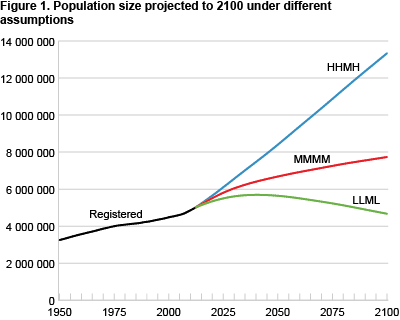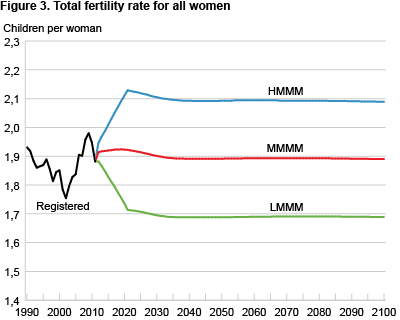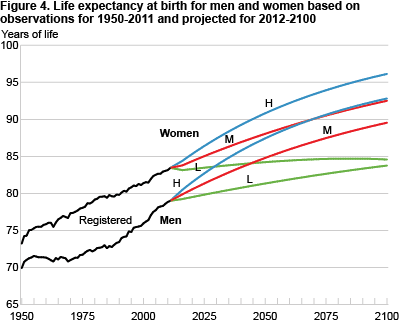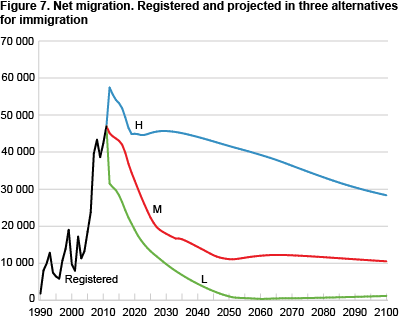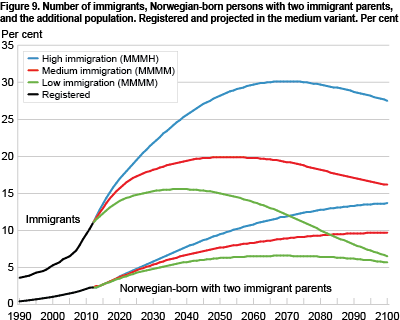Content
Published:
This is an archived release.
Rapidly towards 6 million people
The rapid growth of the population of Norway will probably continue for some time before it slows down. By 2030, we will have passed 6 million, according to the medium projection variant. There is great uncertainty, however, particularly in relation to future immigration.
The new population projections provide figures for all municipalities and counties as well as for the boroughs of Oslo. National figures are provided for the number of immigrants and their Norwegian-born children by country background for three groups of countries. The medium variant, which is regarded as the main projection alternative, shows a substantial population increase over the next 50 years. According to this variant, Norway’s population will pass 6 million in 2029, 7 million in 2063 and 7.9 million in 2100. Figure 1 illustrates this.
The assumptions affect the projection results
There is considerable uncertainty about the extent to which the assumptions will match the actual future trends, especially for immigration. To illustrate the sensitivity of the calculations, we have made projections based on several alternative assumptions. According to the option with the highest population growth (HHMH, which means high fertility, high mortality, medium migration and high domestic migration, see text box), we will pass 6 million as early as 2022, and the population will reach 13 million in 2100. In the scenario with the lowest population growth (LLML), the 6 million mark will not be reached in this century at all. Instead, the population will peak at 5.7 million in 2040 and fall to 4.7 million in 2100. If immigration continues at the same level as in 2011, the population will pass 6 million in 2027, 7 million in 2045, and 9 million in 2086. It is the assumptions about immigration that result in the largest differences in the projected population.
High population growth the first years
The population growth will be particularly strong during the first projection years. According to the main alternative (MMMM), the annual growth will increase from 65 600 in 2011 to 67 500 in 2016. This is primarily due to increased immigration, especially from the EU area. After that, the population growth will slow. This is partly due to the fact that immigrants are more likely to emigrate than the rest of the population. Over time, this leads to a significant increase in emigration, and thus a reduction in net immigration.
The results from the new projections are quite similar to last year’s projections, with a deviation of not more than 0.9 per cent.
Highest growth in Oslo
The population will grow in all counties until 2040, according to the main alternative. The growth is expected to be strongest in Oslo, Akershus and Rogaland. Oslo will grow from 613 000 in 2012 to 832 000 in 2040, which is slightly higher (9 000) than in the 2011 projections. For the first time, Statistics Norway has also projected the population of the 17 boroughs of Oslo. They show that the fastest growth will be in Bjerke and Østensjø, which will increase by more than 40 per cent from 2011 to 2040.
Slightly lower fertility
The Norwegian fertility rate is high in a European context, but has declined somewhat in the last two years. Whether this is the beginning of a new trend or just a random variation is still uncertain. In the middle and low alternatives, the birth rate is slightly lower than in last year's projections, whereas the high alternative remains at the same level. For women who are not immigrants, the total fertility rate (see box) remains constant at 1.87 children per woman throughout the projection period.
For female immigrants, the fertility has been estimated separately for each of the three country groups (see box). Birth rates by age and duration of residence in Norway remain constant in the projections. However, as the average length of residence among immigrants varies, the total fertility rate will also vary for each country group, for all immigrants as a group, and for the whole country, see figures 2 and 3.
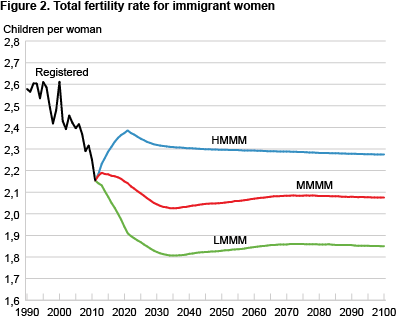
Life expectancy may exceed 90 years
Life expectancy in Norway has been increasing for the past 200 years, and we expect this to continue. The mortality assumptions are based on an analysis of data for the period 1950-2010. They are unchanged from last year's projections, except for the first five years, where the figures have been adjusted slightly to take account of the observations for 2011.
In the main alternative, life expectancy at birth is expected to rise from 79 years in 2011 to 90 years for men and from 83 years in 2011 to 93 years in 2100 for women. In the low alternative, life expectancy is assumed to be 84 years for men and 85 years for women, and in the high alternative it is assumed to be 93 years for men and 96 years for women. The same mortality assumptions are used for all groups, i.e. immigrants, their children born in Norway, and the rest of the population.
Three immigration scenarios
Future immigration is estimated using an economic model where immigration is determined mainly by previous immigration, income level in Norway compared to the level in the three country groups, changes in the unemployment rate, and the population size of each of the country groups. Three alternative paths have been estimated (high, low and medium migration), based on three different scenarios for the Norwegian and global economic future.
In the medium path (M), the income level in Norway relative to the rest of the world is assumed to fall - corresponding to declining petroleum revenues - and eventually level off at 10 per cent above the OECD level. As a result, immigration to Norway will decline in the long term to around 40 000 immigrations annually. Emigration, which partly depends on earlier immigration, will level off at around 30 000 each year. Thus, net immigration will be 10 000-15 000 annually in the long term, according to the medium path.
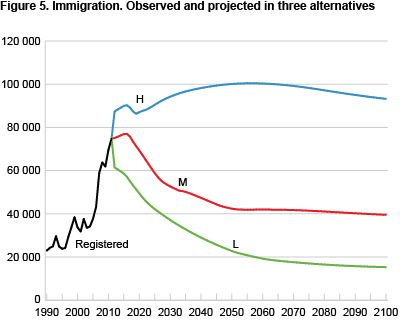
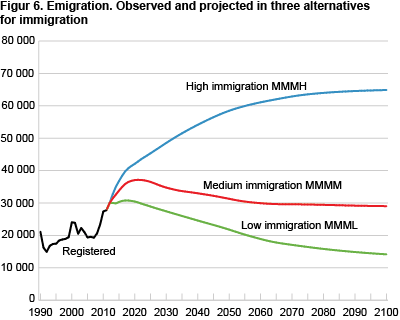
In the low alternative (L), Norway's income level declines all the way down to the OECD level. In addition, country groups 2 and 3 are assumed to have higher economic growth (in per cent) than country group 1. Immigration to Norway will be lower in this alternative, as will emigration. Net immigration drops to below 1 000 from around 2050.
20 per cent immigrants in 2050
The future number of immigrants in Norway varies with the three alternatives. In the medium alternative, around 1.3 million immigrants will live in Norway in 2050. This corresponds to almost 20 per cent of the population. After 2050, this percentage goes down somewhat.
The number of persons born in Norway with two immigrant parents will increase throughout the period, to about 500 000 in 2050 and 750 000 in 2100, increasing every year relative to the number of immigrants. Today, immigrants constitute 11 per cent and their Norwegian-born children 2 per cent of the population. In 2100, these percentages will be 16 and 10 per cent, respectively, according to the medium alternative.
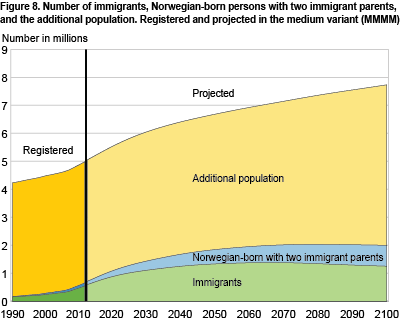
Immigrants and their children born in Norway will make up slightly less than 30 per cent of the population in the long term, according to the medium alternative. In the high alternative, they will reach 40 per cent before the proportion levels off. In the low alternative, the proportion reaches just over 20 per cent before it goes down again.
More from all country groups
In 2050, Norway will have 250 000 immigrants from Country group 1 (Western European countries and the USA, Canada, Australia and New Zealand), 300 000 from Country group 2 (eastern EU countries), and 800 000 from Country group 3 (rest of the world), according to the medium variant. The three immigrant groups will account for 4, 5 and 12 per cent of the total population in 2050.
Among people born in Norway with two immigrant parents, 40 000 will have a background from Country group 1, 110 000 from Country group 2 and 360 000 from Country group 3 in 2050, according to the main alternative. This corresponds to 1, 2 and 5 per cent of the total 2050 population.
From 2050 to 2100, the number of immigrants from Group 1 will remain fairly stable, while the number of immigrants from Group 2 will be significantly reduced, to 150 000 in 2100. From Group 3 countries, the number of immigrants will rise to almost 900 000, according to the main variant. The number of persons born to immigrant parents in Norway, however, will increase for all three groups until 2100, to 50 000, 130 000 and 560 000 respectively.
More detailed figures can be found in the tables below and in the Statbank.
Definitions and explanationsPopulation projection : An estimate of the future size and composition of a population, usually by sex, age and residence (municipality). This is done by the application of probabilities or rates for deaths, in- and out-migration and fertility (for women aged 15-49). For immigrants and their children born in Norway we use emigration probabilities and birth rates by sex, age and country group, see below, and also by duration of stay in Norway for immigrants. Models : Two models have been used to project the population:* The first model, BEFINN, projects the population of immigrants and their children born in Norway as well as the additional population, by sex and age, for the whole country. Immigrants and their children born in Norway are also projected by country background, and immigrants by duration of stay in Norway. * The second model, BEFFREG, projects the population by sex and age for the 429 municipalities of Norway, and the Oslo boroughs. The results from this are adjusted to assure consistency at national level with the BEFINN results. Alternatives : Alternative assumptions are made for each of the four components of the projections: fertility, life expectancy, inter-municipal migration and immigration . The assumptions are designated as L (low), M (medium), H (high), K (constant) or 0 (for migration in Norway and for immigration and emigration). The main variant MMMM assumes the medium level for each component. Alternative assumptions have been made about immigration and not about net immigration, as previously. Emigration and net immigration are computed by the model and follow from the assumptions that have been made. Country groups : (1) Countries in the EU/EEA/EFTA in Western Europe and USA, Canada, Australia and New Zealand. (2) EU countries in Eastern Europe. (3) Rest of the world, i.e. rest of Europe, Asia, Africa, Latin America and Oceania except Australia and New Zealand. (0) Norway, i.e. the additional population. Immigrant : Person born abroad with two foreign-born parents and who has immigrated to Norway. Net migration is the difference between the number of migrations to and from the country during a period. Life expectancy is the expected number of years a person can expect to live according to the death rates in a given period, usually a calendar year. It is usually estimated at birth but can also be estimated for other ages. Total fertility rate (TFR) is the sum of age-specific fertility rates for women 15-49 years of age in a calendar year. It can be interpreted as the average number of children per woman on the assumption that the fertility pattern is continuing and that there are no deaths before age 50. The TFR has to be greater than 2.06-2.07 children (the reproduction level) in order to prevent a population decline in the long term, excluding immigration and emigration. |
| Registered | Alternatives | ||||||||||||||||||||||||||||||||||||||||||||||||||||||||||||||||||||||||||||||
|---|---|---|---|---|---|---|---|---|---|---|---|---|---|---|---|---|---|---|---|---|---|---|---|---|---|---|---|---|---|---|---|---|---|---|---|---|---|---|---|---|---|---|---|---|---|---|---|---|---|---|---|---|---|---|---|---|---|---|---|---|---|---|---|---|---|---|---|---|---|---|---|---|---|---|---|---|---|---|---|
| L | M | H | K | 0 | |||||||||||||||||||||||||||||||||||||||||||||||||||||||||||||||||||||||||||
| Total fertility rate (children per woman) | |||||||||||||||||||||||||||||||||||||||||||||||||||||||||||||||||||||||||||||||
| 2011 | 1.88 | ||||||||||||||||||||||||||||||||||||||||||||||||||||||||||||||||||||||||||||||
| 2012 | 1.88 | 1.91 | 1.95 | ||||||||||||||||||||||||||||||||||||||||||||||||||||||||||||||||||||||||||||
| 2100 | 1.69 | 1.89 | 2.09 | ||||||||||||||||||||||||||||||||||||||||||||||||||||||||||||||||||||||||||||
| Lie expectancy at birth for men (years) | |||||||||||||||||||||||||||||||||||||||||||||||||||||||||||||||||||||||||||||||
| 2011 | 79.0 | ||||||||||||||||||||||||||||||||||||||||||||||||||||||||||||||||||||||||||||||
| 2012 | 79.0 | 79.2 | 79.3 | 79.2 | |||||||||||||||||||||||||||||||||||||||||||||||||||||||||||||||||||||||||||
| 2100 | 83.8 | 89.5 | 92.8 | 79.2 | |||||||||||||||||||||||||||||||||||||||||||||||||||||||||||||||||||||||||||
| Lie expectancy at birth for women (years) | |||||||||||||||||||||||||||||||||||||||||||||||||||||||||||||||||||||||||||||||
| 2011 | 83.4 | ||||||||||||||||||||||||||||||||||||||||||||||||||||||||||||||||||||||||||||||
| 2012 | 83.4 | 83.5 | 83.6 | 83.6 | |||||||||||||||||||||||||||||||||||||||||||||||||||||||||||||||||||||||||||
| 2100 | 84.6 | 92.5 | 96.1 | 83.6 | |||||||||||||||||||||||||||||||||||||||||||||||||||||||||||||||||||||||||||
| Immigrations per year 2 | |||||||||||||||||||||||||||||||||||||||||||||||||||||||||||||||||||||||||||||||
| 2011 | 74 785 | ||||||||||||||||||||||||||||||||||||||||||||||||||||||||||||||||||||||||||||||
| 2012 | 62 000 | 76 000 | 88 000 | 75 000 | 0 | ||||||||||||||||||||||||||||||||||||||||||||||||||||||||||||||||||||||||||
| 2100 | 15 000 | 40 000 | 94 000 | 75 000 | 0 | ||||||||||||||||||||||||||||||||||||||||||||||||||||||||||||||||||||||||||
| Net immigration per year | |||||||||||||||||||||||||||||||||||||||||||||||||||||||||||||||||||||||||||||||
| 2011 | 47 000 | ||||||||||||||||||||||||||||||||||||||||||||||||||||||||||||||||||||||||||||||
| 2012 | 32 000 | 46 000 | 58 000 | 57 000 | 0 | ||||||||||||||||||||||||||||||||||||||||||||||||||||||||||||||||||||||||||
| 2100 | 1 000 | 11 000 | 29 000 | 24 000 | 0 | ||||||||||||||||||||||||||||||||||||||||||||||||||||||||||||||||||||||||||
| 1 | L = low, M = medium, H = high, K = constant, 0 = no migrations across international or municipal borders. |
| 2 | These numbers do not include persons who have migrated several times to and from Norway in one calendar year. In 2011 there were totally 79 498 immigrations to Norway. |
Background material is presented in Norwegian in Økonomiske analyser no. 4, 2012: : |
Tables:
- Table 1 Population 1 January. Registered 2012. Projected 2013-2100 in fourteen variants. In 1 000 persons
- Table 2 Number of births and deaths. Absolute and relatve population growth. Registered 2011. Projected 2012-2100 in various variants. 1 000 persons
- Table 3 Immigration, emigration and net migration, total and for immigrants, by country background. Registered 2011. Projected 2012-2060 in three variants. In 1 000 persons
- Table 4 Immigrants, Norwegian-born to two immigrant parents and the rest of the population. Registered 2012. Projected 2013-2100, by country background, in three variants. 1 000 persons
- Table 5 Total fertility rate for all women and for immigrant women from three groups of countries. Registered 2011. Projected 2012-2100 by three variants
- Table 6 Life expectancy for males and females. Registered 2011. Projected 2012-2100 in three variants
Contact
-
Statistics Norway's Information Centre
E-mail: informasjon@ssb.no
tel.: (+47) 21 09 46 42
-
Inquiries about national projections
E-mail: nasjfram@ssb.no
-
Inquiries about regional projections
E-mail: regfram@ssb.no
-
Michael Thomas
E-mail: michael.thomas@ssb.no
tel.: (+47) 40 90 26 28
-
Ane Margrete Tømmerås
E-mail: ane.tommeras@ssb.no
tel.: (+47) 91 99 29 62

